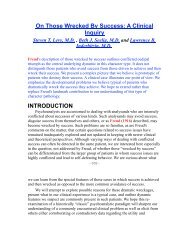A Sadomasochistic Transference - Beth J. Seelig, MD
A Sadomasochistic Transference - Beth J. Seelig, MD
A Sadomasochistic Transference - Beth J. Seelig, MD
You also want an ePaper? Increase the reach of your titles
YUMPU automatically turns print PDFs into web optimized ePapers that Google loves.
primitive dyadic maternal-infant issues, along with concomitant primitive<br />
defensive operations and intense, unmodulated affect states. Such shifting<br />
transference patterns are described by Kernberg (1984), (1988b) in his extensive<br />
work on character pathology.<br />
The intense, sticky, sadomasochistic tie to the analyst was a recreation in the<br />
transference of the perversion of intimacy that had been established between Miss<br />
T. and her mother. Neither could disengage from the struggle with the other. In the<br />
transference, Miss T. expressed this dilemma very clearly when she said "there's<br />
no choice … we'll sit in this battle for years and years." In struggling with this<br />
difficult transference, we came to the conclusion that Miss T.'s inability to let go of<br />
the painful bond had multiple determinants: the erotization of her suffering, the<br />
narcissistic gratification of being special, the<br />
- 982 -<br />
ego enhancement of a fluctuating identification with the aggressor, an inhibition<br />
(or repudiation) of preoedipal and oedipal triangulation, and the sense of intimacy<br />
(though distorted) generated in the sadomasochistic exchange. In the course of<br />
working through these issues, Miss T. also came to understand her guilty selftorture<br />
(alternating with her sense of victimization) as being the price she paid for<br />
her sadistic counterattack, her own participation in psychically abusing others as<br />
she experienced them abusing her. With this new understanding she became able<br />
to engage in the analytic process without the previous agony of being either the<br />
suffering victim or the guilty victimizer.<br />
Discussion<br />
Distortions in the Mother-Child Dyad as a precursor of<br />
Sadomasochism<br />
Zetzel (1968) in her classic paper, "The So-Called Good Hysteric," describes<br />
the variations in degrees of psychopathology in characterologically hysterical<br />
patients. In this paper, she uses the same rhyme about the little girl who was<br />
alternatively very good and very bad to describe the "not-so-good hysteric" as<br />
Miss T.'s mother had used in describing her daughter. Originally seen as a hysteric,<br />
Miss T. could be described as a Zetzel type II or III. Easser and Lesser (1965)<br />
called such patients "hysteroid," indicating that their problems were preoedipal.<br />
There is a growing body of work relevant to the kinds of early experiences<br />
that promote distortions in object relations and in self-concept like those Miss T.<br />
presents. Kohut (1971), in his well-known work on narcissism, stresses the<br />
importance of early empathic "mirroring" in the development of a normal self. He<br />
states that narcissistic pathology results from the mother's use of the child as a




